Federation University BUMGT5921: Diversity in Workplace Report
VerifiedAdded on 2022/09/18
|7
|1946
|23
Report
AI Summary
This report delves into the multifaceted realm of workplace diversity, exploring its significance and impact on organizational success. It begins by defining diversity management and highlighting its importance in today's business environment, emphasizing the need for organizations to embrace a heterogeneous workforce to meet customer demands and foster innovation. The report examines the benefits of diversity, such as enhanced creativity, market understanding, and competitive advantage. However, it also acknowledges the challenges, including increased training costs, potential conflicts, and issues related to absenteeism. The report further analyzes diversity management practices, including the importance of corporate culture, equal opportunity, and the role of leadership in promoting diversity. It discusses various initiatives such as assigning diversity concerns to senior management and integrating diversity considerations into HR decisions. The report draws on various research and expert opinions to provide a comprehensive understanding of the benefits and issues of diversity in the workplace and the strategies for effective management. The report also includes references to support the arguments made.
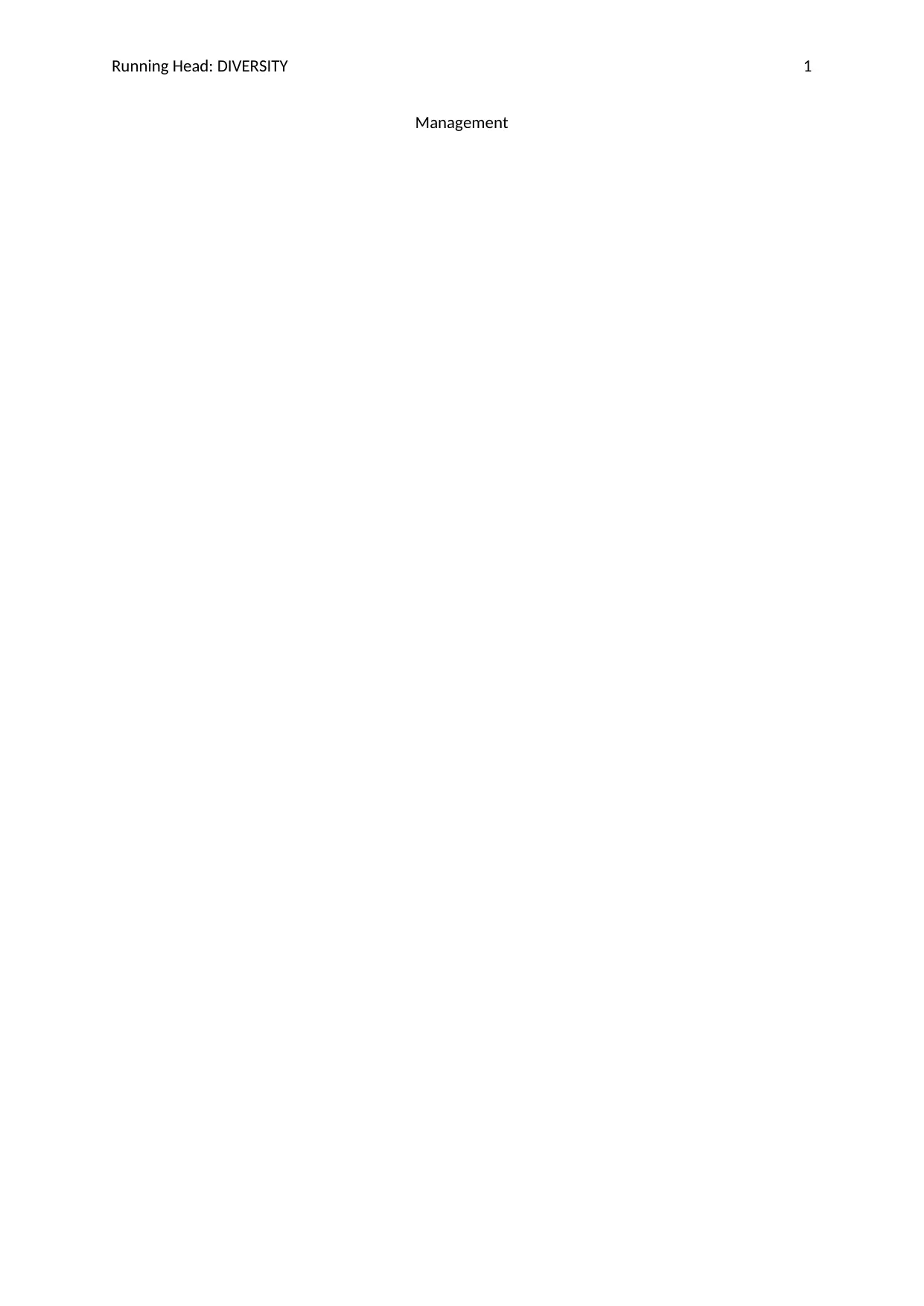
Running Head: DIVERSITY 1
Management
Management
Paraphrase This Document
Need a fresh take? Get an instant paraphrase of this document with our AI Paraphraser
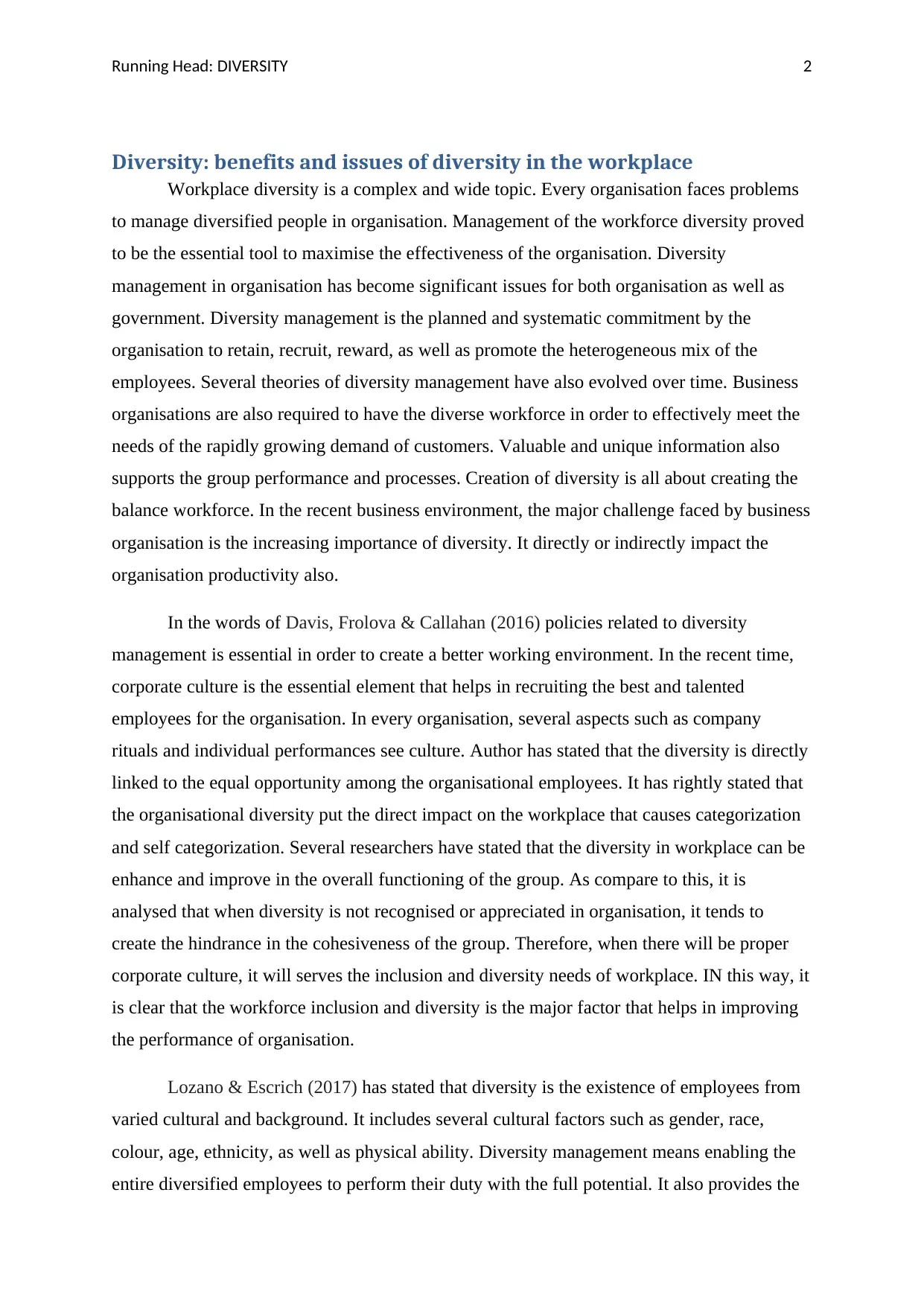
Running Head: DIVERSITY 2
Diversity: benefits and issues of diversity in the workplace
Workplace diversity is a complex and wide topic. Every organisation faces problems
to manage diversified people in organisation. Management of the workforce diversity proved
to be the essential tool to maximise the effectiveness of the organisation. Diversity
management in organisation has become significant issues for both organisation as well as
government. Diversity management is the planned and systematic commitment by the
organisation to retain, recruit, reward, as well as promote the heterogeneous mix of the
employees. Several theories of diversity management have also evolved over time. Business
organisations are also required to have the diverse workforce in order to effectively meet the
needs of the rapidly growing demand of customers. Valuable and unique information also
supports the group performance and processes. Creation of diversity is all about creating the
balance workforce. In the recent business environment, the major challenge faced by business
organisation is the increasing importance of diversity. It directly or indirectly impact the
organisation productivity also.
In the words of Davis, Frolova & Callahan (2016) policies related to diversity
management is essential in order to create a better working environment. In the recent time,
corporate culture is the essential element that helps in recruiting the best and talented
employees for the organisation. In every organisation, several aspects such as company
rituals and individual performances see culture. Author has stated that the diversity is directly
linked to the equal opportunity among the organisational employees. It has rightly stated that
the organisational diversity put the direct impact on the workplace that causes categorization
and self categorization. Several researchers have stated that the diversity in workplace can be
enhance and improve in the overall functioning of the group. As compare to this, it is
analysed that when diversity is not recognised or appreciated in organisation, it tends to
create the hindrance in the cohesiveness of the group. Therefore, when there will be proper
corporate culture, it will serves the inclusion and diversity needs of workplace. IN this way, it
is clear that the workforce inclusion and diversity is the major factor that helps in improving
the performance of organisation.
Lozano & Escrich (2017) has stated that diversity is the existence of employees from
varied cultural and background. It includes several cultural factors such as gender, race,
colour, age, ethnicity, as well as physical ability. Diversity management means enabling the
entire diversified employees to perform their duty with the full potential. It also provides the
Diversity: benefits and issues of diversity in the workplace
Workplace diversity is a complex and wide topic. Every organisation faces problems
to manage diversified people in organisation. Management of the workforce diversity proved
to be the essential tool to maximise the effectiveness of the organisation. Diversity
management in organisation has become significant issues for both organisation as well as
government. Diversity management is the planned and systematic commitment by the
organisation to retain, recruit, reward, as well as promote the heterogeneous mix of the
employees. Several theories of diversity management have also evolved over time. Business
organisations are also required to have the diverse workforce in order to effectively meet the
needs of the rapidly growing demand of customers. Valuable and unique information also
supports the group performance and processes. Creation of diversity is all about creating the
balance workforce. In the recent business environment, the major challenge faced by business
organisation is the increasing importance of diversity. It directly or indirectly impact the
organisation productivity also.
In the words of Davis, Frolova & Callahan (2016) policies related to diversity
management is essential in order to create a better working environment. In the recent time,
corporate culture is the essential element that helps in recruiting the best and talented
employees for the organisation. In every organisation, several aspects such as company
rituals and individual performances see culture. Author has stated that the diversity is directly
linked to the equal opportunity among the organisational employees. It has rightly stated that
the organisational diversity put the direct impact on the workplace that causes categorization
and self categorization. Several researchers have stated that the diversity in workplace can be
enhance and improve in the overall functioning of the group. As compare to this, it is
analysed that when diversity is not recognised or appreciated in organisation, it tends to
create the hindrance in the cohesiveness of the group. Therefore, when there will be proper
corporate culture, it will serves the inclusion and diversity needs of workplace. IN this way, it
is clear that the workforce inclusion and diversity is the major factor that helps in improving
the performance of organisation.
Lozano & Escrich (2017) has stated that diversity is the existence of employees from
varied cultural and background. It includes several cultural factors such as gender, race,
colour, age, ethnicity, as well as physical ability. Diversity management means enabling the
entire diversified employees to perform their duty with the full potential. It also provides the
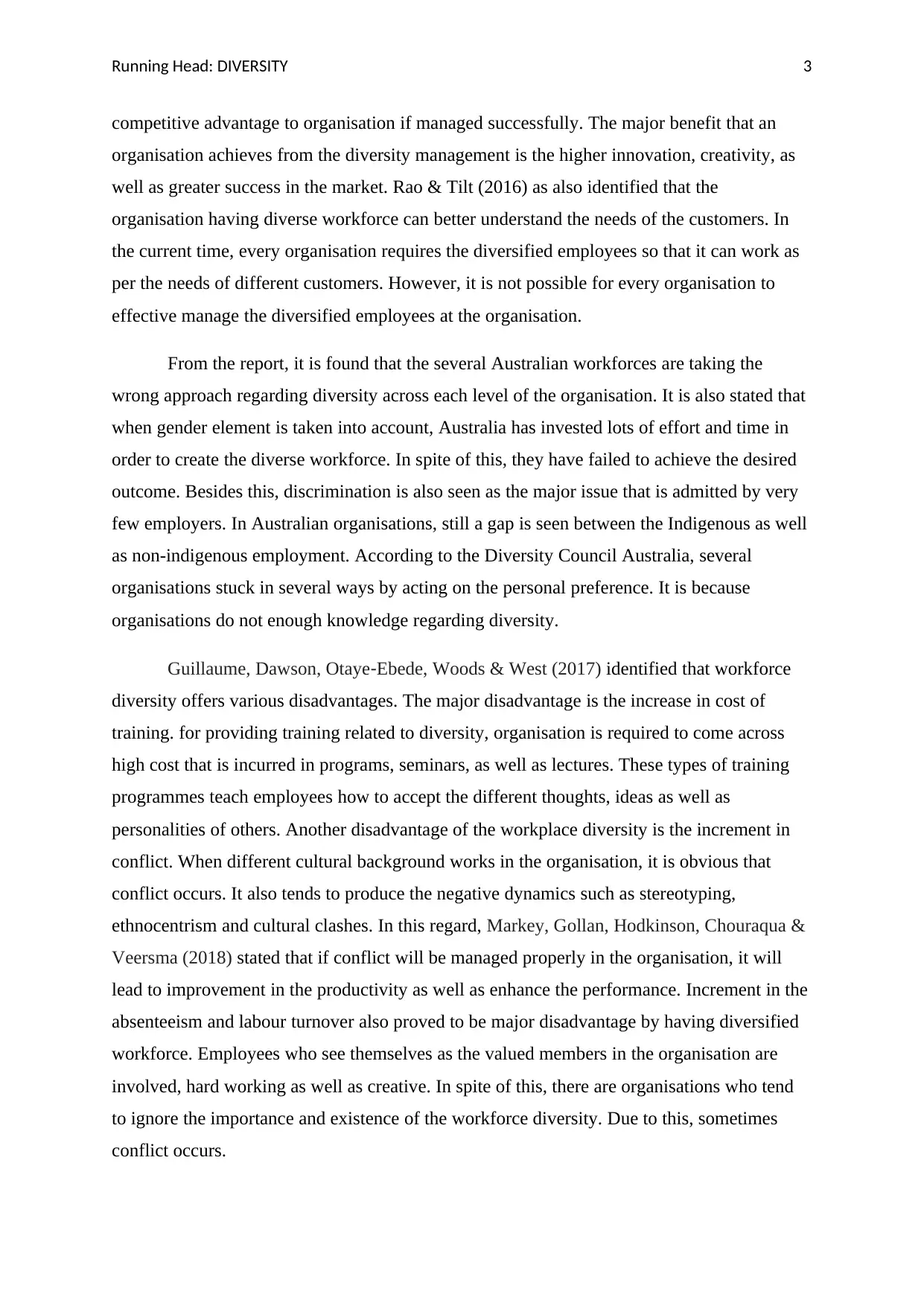
Running Head: DIVERSITY 3
competitive advantage to organisation if managed successfully. The major benefit that an
organisation achieves from the diversity management is the higher innovation, creativity, as
well as greater success in the market. Rao & Tilt (2016) as also identified that the
organisation having diverse workforce can better understand the needs of the customers. In
the current time, every organisation requires the diversified employees so that it can work as
per the needs of different customers. However, it is not possible for every organisation to
effective manage the diversified employees at the organisation.
From the report, it is found that the several Australian workforces are taking the
wrong approach regarding diversity across each level of the organisation. It is also stated that
when gender element is taken into account, Australia has invested lots of effort and time in
order to create the diverse workforce. In spite of this, they have failed to achieve the desired
outcome. Besides this, discrimination is also seen as the major issue that is admitted by very
few employers. In Australian organisations, still a gap is seen between the Indigenous as well
as non-indigenous employment. According to the Diversity Council Australia, several
organisations stuck in several ways by acting on the personal preference. It is because
organisations do not enough knowledge regarding diversity.
Guillaume, Dawson, Otaye‐Ebede, Woods & West (2017) identified that workforce
diversity offers various disadvantages. The major disadvantage is the increase in cost of
training. for providing training related to diversity, organisation is required to come across
high cost that is incurred in programs, seminars, as well as lectures. These types of training
programmes teach employees how to accept the different thoughts, ideas as well as
personalities of others. Another disadvantage of the workplace diversity is the increment in
conflict. When different cultural background works in the organisation, it is obvious that
conflict occurs. It also tends to produce the negative dynamics such as stereotyping,
ethnocentrism and cultural clashes. In this regard, Markey, Gollan, Hodkinson, Chouraqua &
Veersma (2018) stated that if conflict will be managed properly in the organisation, it will
lead to improvement in the productivity as well as enhance the performance. Increment in the
absenteeism and labour turnover also proved to be major disadvantage by having diversified
workforce. Employees who see themselves as the valued members in the organisation are
involved, hard working as well as creative. In spite of this, there are organisations who tend
to ignore the importance and existence of the workforce diversity. Due to this, sometimes
conflict occurs.
competitive advantage to organisation if managed successfully. The major benefit that an
organisation achieves from the diversity management is the higher innovation, creativity, as
well as greater success in the market. Rao & Tilt (2016) as also identified that the
organisation having diverse workforce can better understand the needs of the customers. In
the current time, every organisation requires the diversified employees so that it can work as
per the needs of different customers. However, it is not possible for every organisation to
effective manage the diversified employees at the organisation.
From the report, it is found that the several Australian workforces are taking the
wrong approach regarding diversity across each level of the organisation. It is also stated that
when gender element is taken into account, Australia has invested lots of effort and time in
order to create the diverse workforce. In spite of this, they have failed to achieve the desired
outcome. Besides this, discrimination is also seen as the major issue that is admitted by very
few employers. In Australian organisations, still a gap is seen between the Indigenous as well
as non-indigenous employment. According to the Diversity Council Australia, several
organisations stuck in several ways by acting on the personal preference. It is because
organisations do not enough knowledge regarding diversity.
Guillaume, Dawson, Otaye‐Ebede, Woods & West (2017) identified that workforce
diversity offers various disadvantages. The major disadvantage is the increase in cost of
training. for providing training related to diversity, organisation is required to come across
high cost that is incurred in programs, seminars, as well as lectures. These types of training
programmes teach employees how to accept the different thoughts, ideas as well as
personalities of others. Another disadvantage of the workplace diversity is the increment in
conflict. When different cultural background works in the organisation, it is obvious that
conflict occurs. It also tends to produce the negative dynamics such as stereotyping,
ethnocentrism and cultural clashes. In this regard, Markey, Gollan, Hodkinson, Chouraqua &
Veersma (2018) stated that if conflict will be managed properly in the organisation, it will
lead to improvement in the productivity as well as enhance the performance. Increment in the
absenteeism and labour turnover also proved to be major disadvantage by having diversified
workforce. Employees who see themselves as the valued members in the organisation are
involved, hard working as well as creative. In spite of this, there are organisations who tend
to ignore the importance and existence of the workforce diversity. Due to this, sometimes
conflict occurs.
⊘ This is a preview!⊘
Do you want full access?
Subscribe today to unlock all pages.

Trusted by 1+ million students worldwide
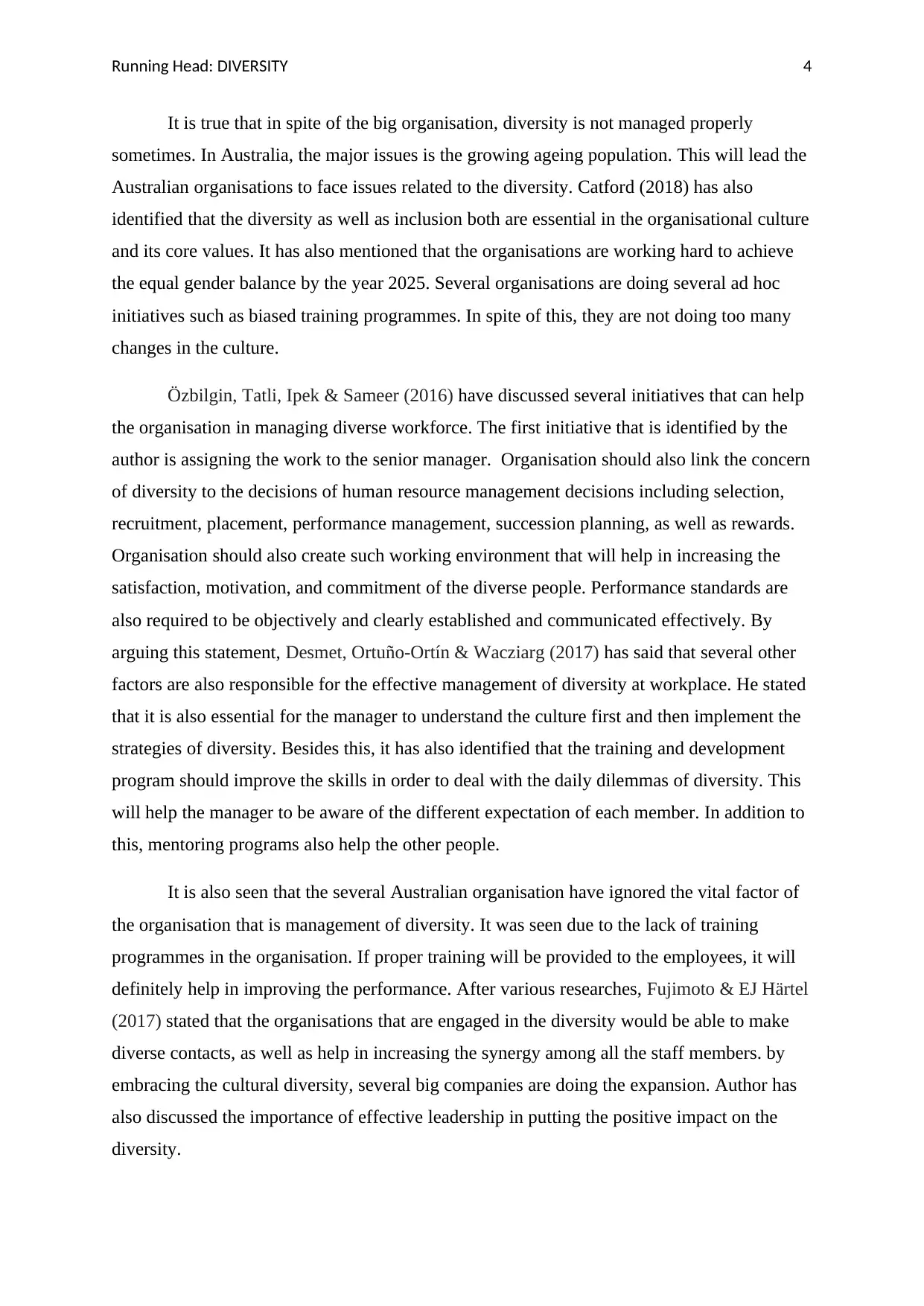
Running Head: DIVERSITY 4
It is true that in spite of the big organisation, diversity is not managed properly
sometimes. In Australia, the major issues is the growing ageing population. This will lead the
Australian organisations to face issues related to the diversity. Catford (2018) has also
identified that the diversity as well as inclusion both are essential in the organisational culture
and its core values. It has also mentioned that the organisations are working hard to achieve
the equal gender balance by the year 2025. Several organisations are doing several ad hoc
initiatives such as biased training programmes. In spite of this, they are not doing too many
changes in the culture.
Özbilgin, Tatli, Ipek & Sameer (2016) have discussed several initiatives that can help
the organisation in managing diverse workforce. The first initiative that is identified by the
author is assigning the work to the senior manager. Organisation should also link the concern
of diversity to the decisions of human resource management decisions including selection,
recruitment, placement, performance management, succession planning, as well as rewards.
Organisation should also create such working environment that will help in increasing the
satisfaction, motivation, and commitment of the diverse people. Performance standards are
also required to be objectively and clearly established and communicated effectively. By
arguing this statement, Desmet, Ortuño-Ortín & Wacziarg (2017) has said that several other
factors are also responsible for the effective management of diversity at workplace. He stated
that it is also essential for the manager to understand the culture first and then implement the
strategies of diversity. Besides this, it has also identified that the training and development
program should improve the skills in order to deal with the daily dilemmas of diversity. This
will help the manager to be aware of the different expectation of each member. In addition to
this, mentoring programs also help the other people.
It is also seen that the several Australian organisation have ignored the vital factor of
the organisation that is management of diversity. It was seen due to the lack of training
programmes in the organisation. If proper training will be provided to the employees, it will
definitely help in improving the performance. After various researches, Fujimoto & EJ Härtel
(2017) stated that the organisations that are engaged in the diversity would be able to make
diverse contacts, as well as help in increasing the synergy among all the staff members. by
embracing the cultural diversity, several big companies are doing the expansion. Author has
also discussed the importance of effective leadership in putting the positive impact on the
diversity.
It is true that in spite of the big organisation, diversity is not managed properly
sometimes. In Australia, the major issues is the growing ageing population. This will lead the
Australian organisations to face issues related to the diversity. Catford (2018) has also
identified that the diversity as well as inclusion both are essential in the organisational culture
and its core values. It has also mentioned that the organisations are working hard to achieve
the equal gender balance by the year 2025. Several organisations are doing several ad hoc
initiatives such as biased training programmes. In spite of this, they are not doing too many
changes in the culture.
Özbilgin, Tatli, Ipek & Sameer (2016) have discussed several initiatives that can help
the organisation in managing diverse workforce. The first initiative that is identified by the
author is assigning the work to the senior manager. Organisation should also link the concern
of diversity to the decisions of human resource management decisions including selection,
recruitment, placement, performance management, succession planning, as well as rewards.
Organisation should also create such working environment that will help in increasing the
satisfaction, motivation, and commitment of the diverse people. Performance standards are
also required to be objectively and clearly established and communicated effectively. By
arguing this statement, Desmet, Ortuño-Ortín & Wacziarg (2017) has said that several other
factors are also responsible for the effective management of diversity at workplace. He stated
that it is also essential for the manager to understand the culture first and then implement the
strategies of diversity. Besides this, it has also identified that the training and development
program should improve the skills in order to deal with the daily dilemmas of diversity. This
will help the manager to be aware of the different expectation of each member. In addition to
this, mentoring programs also help the other people.
It is also seen that the several Australian organisation have ignored the vital factor of
the organisation that is management of diversity. It was seen due to the lack of training
programmes in the organisation. If proper training will be provided to the employees, it will
definitely help in improving the performance. After various researches, Fujimoto & EJ Härtel
(2017) stated that the organisations that are engaged in the diversity would be able to make
diverse contacts, as well as help in increasing the synergy among all the staff members. by
embracing the cultural diversity, several big companies are doing the expansion. Author has
also discussed the importance of effective leadership in putting the positive impact on the
diversity.
Paraphrase This Document
Need a fresh take? Get an instant paraphrase of this document with our AI Paraphraser
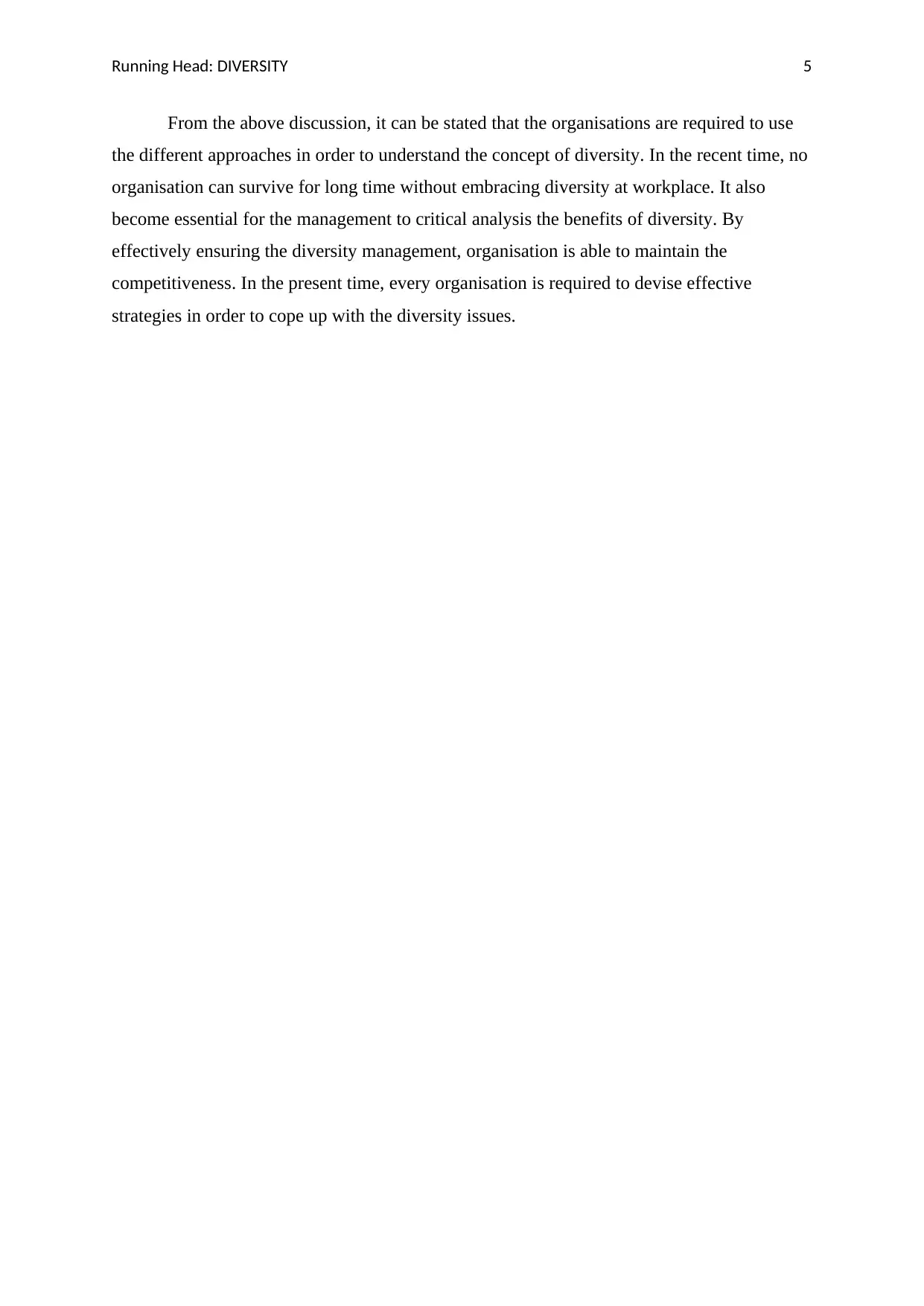
Running Head: DIVERSITY 5
From the above discussion, it can be stated that the organisations are required to use
the different approaches in order to understand the concept of diversity. In the recent time, no
organisation can survive for long time without embracing diversity at workplace. It also
become essential for the management to critical analysis the benefits of diversity. By
effectively ensuring the diversity management, organisation is able to maintain the
competitiveness. In the present time, every organisation is required to devise effective
strategies in order to cope up with the diversity issues.
From the above discussion, it can be stated that the organisations are required to use
the different approaches in order to understand the concept of diversity. In the recent time, no
organisation can survive for long time without embracing diversity at workplace. It also
become essential for the management to critical analysis the benefits of diversity. By
effectively ensuring the diversity management, organisation is able to maintain the
competitiveness. In the present time, every organisation is required to devise effective
strategies in order to cope up with the diversity issues.
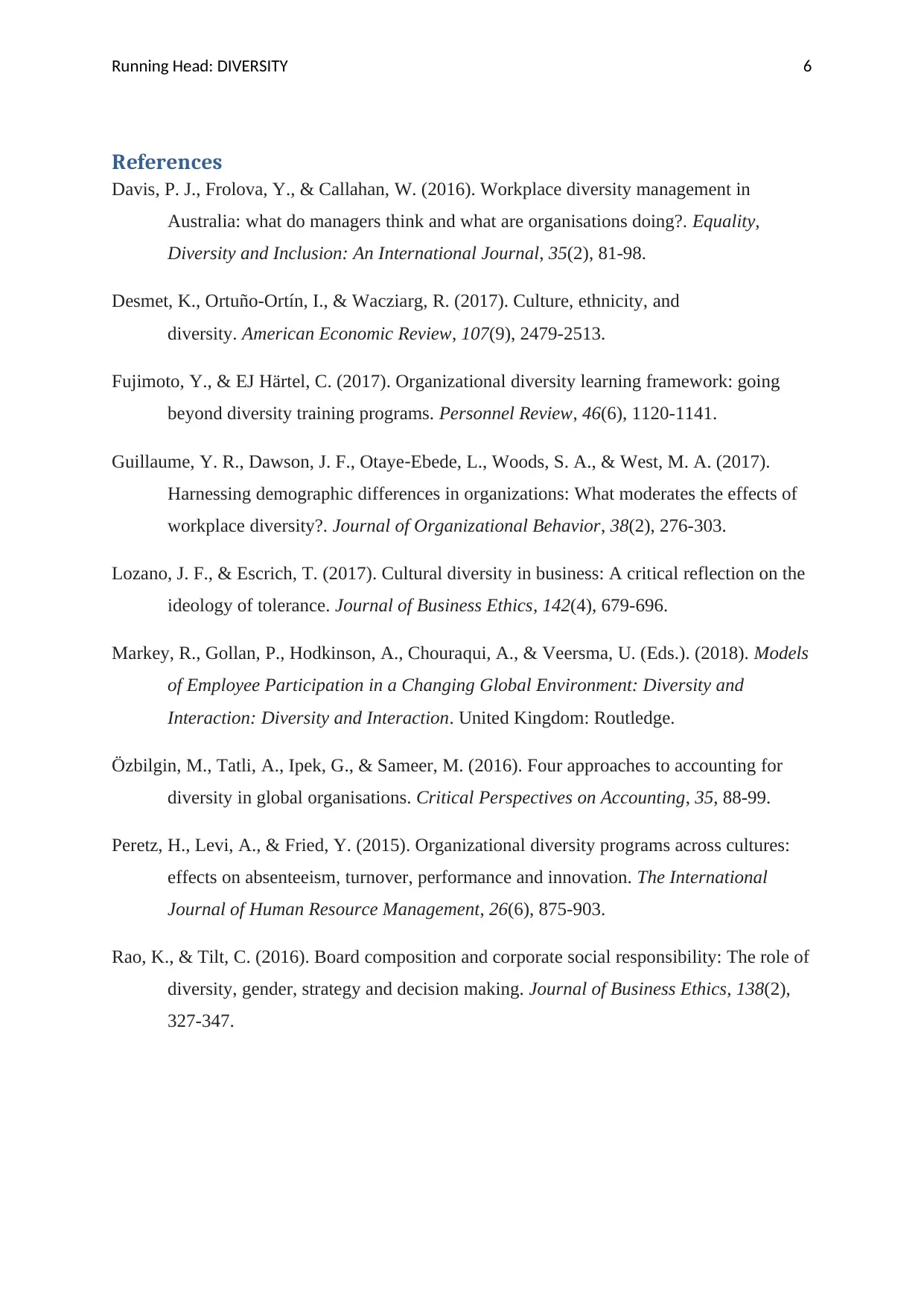
Running Head: DIVERSITY 6
References
Davis, P. J., Frolova, Y., & Callahan, W. (2016). Workplace diversity management in
Australia: what do managers think and what are organisations doing?. Equality,
Diversity and Inclusion: An International Journal, 35(2), 81-98.
Desmet, K., Ortuño-Ortín, I., & Wacziarg, R. (2017). Culture, ethnicity, and
diversity. American Economic Review, 107(9), 2479-2513.
Fujimoto, Y., & EJ Härtel, C. (2017). Organizational diversity learning framework: going
beyond diversity training programs. Personnel Review, 46(6), 1120-1141.
Guillaume, Y. R., Dawson, J. F., Otaye‐Ebede, L., Woods, S. A., & West, M. A. (2017).
Harnessing demographic differences in organizations: What moderates the effects of
workplace diversity?. Journal of Organizational Behavior, 38(2), 276-303.
Lozano, J. F., & Escrich, T. (2017). Cultural diversity in business: A critical reflection on the
ideology of tolerance. Journal of Business Ethics, 142(4), 679-696.
Markey, R., Gollan, P., Hodkinson, A., Chouraqui, A., & Veersma, U. (Eds.). (2018). Models
of Employee Participation in a Changing Global Environment: Diversity and
Interaction: Diversity and Interaction. United Kingdom: Routledge.
Özbilgin, M., Tatli, A., Ipek, G., & Sameer, M. (2016). Four approaches to accounting for
diversity in global organisations. Critical Perspectives on Accounting, 35, 88-99.
Peretz, H., Levi, A., & Fried, Y. (2015). Organizational diversity programs across cultures:
effects on absenteeism, turnover, performance and innovation. The International
Journal of Human Resource Management, 26(6), 875-903.
Rao, K., & Tilt, C. (2016). Board composition and corporate social responsibility: The role of
diversity, gender, strategy and decision making. Journal of Business Ethics, 138(2),
327-347.
References
Davis, P. J., Frolova, Y., & Callahan, W. (2016). Workplace diversity management in
Australia: what do managers think and what are organisations doing?. Equality,
Diversity and Inclusion: An International Journal, 35(2), 81-98.
Desmet, K., Ortuño-Ortín, I., & Wacziarg, R. (2017). Culture, ethnicity, and
diversity. American Economic Review, 107(9), 2479-2513.
Fujimoto, Y., & EJ Härtel, C. (2017). Organizational diversity learning framework: going
beyond diversity training programs. Personnel Review, 46(6), 1120-1141.
Guillaume, Y. R., Dawson, J. F., Otaye‐Ebede, L., Woods, S. A., & West, M. A. (2017).
Harnessing demographic differences in organizations: What moderates the effects of
workplace diversity?. Journal of Organizational Behavior, 38(2), 276-303.
Lozano, J. F., & Escrich, T. (2017). Cultural diversity in business: A critical reflection on the
ideology of tolerance. Journal of Business Ethics, 142(4), 679-696.
Markey, R., Gollan, P., Hodkinson, A., Chouraqui, A., & Veersma, U. (Eds.). (2018). Models
of Employee Participation in a Changing Global Environment: Diversity and
Interaction: Diversity and Interaction. United Kingdom: Routledge.
Özbilgin, M., Tatli, A., Ipek, G., & Sameer, M. (2016). Four approaches to accounting for
diversity in global organisations. Critical Perspectives on Accounting, 35, 88-99.
Peretz, H., Levi, A., & Fried, Y. (2015). Organizational diversity programs across cultures:
effects on absenteeism, turnover, performance and innovation. The International
Journal of Human Resource Management, 26(6), 875-903.
Rao, K., & Tilt, C. (2016). Board composition and corporate social responsibility: The role of
diversity, gender, strategy and decision making. Journal of Business Ethics, 138(2),
327-347.
⊘ This is a preview!⊘
Do you want full access?
Subscribe today to unlock all pages.

Trusted by 1+ million students worldwide
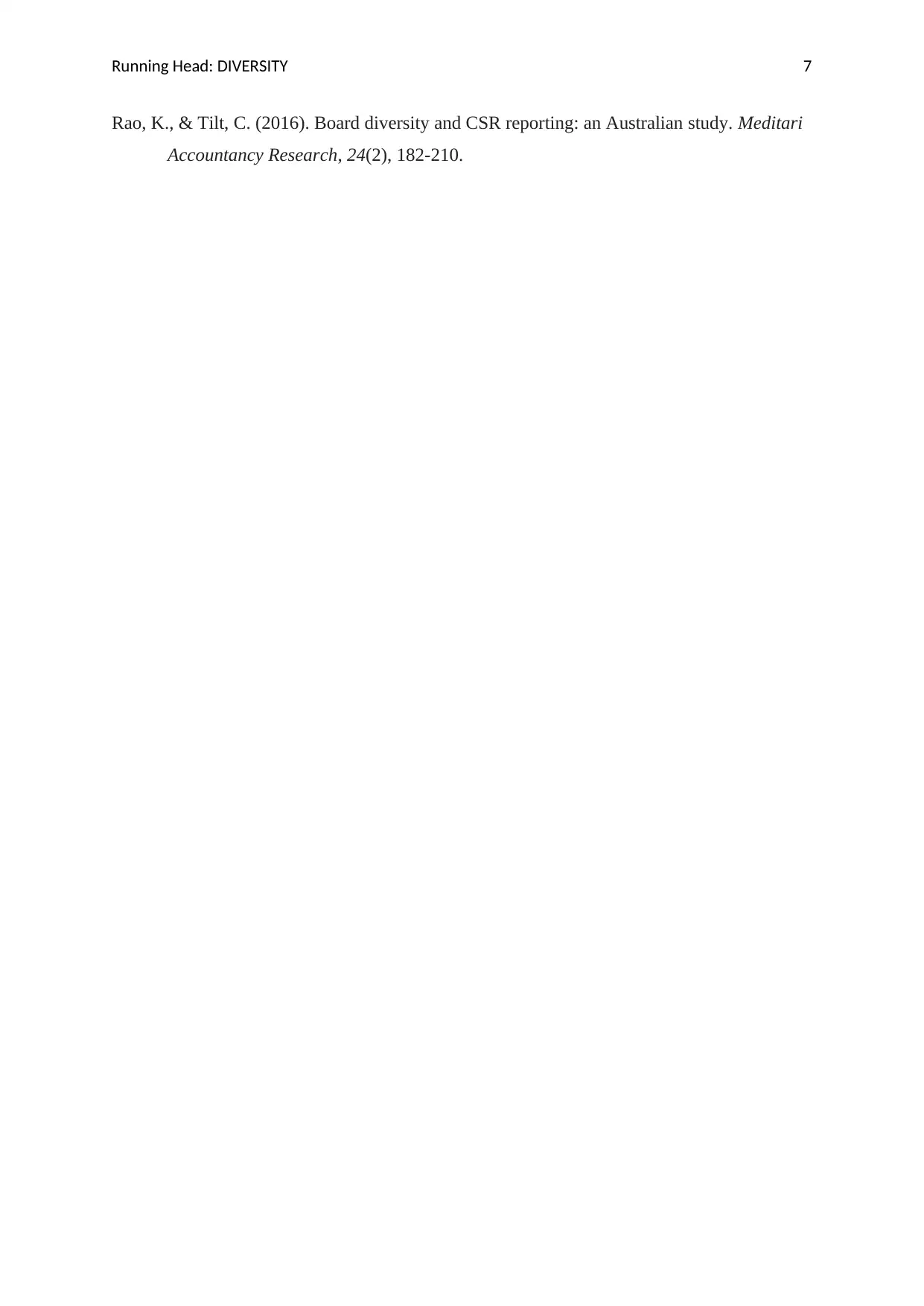
Running Head: DIVERSITY 7
Rao, K., & Tilt, C. (2016). Board diversity and CSR reporting: an Australian study. Meditari
Accountancy Research, 24(2), 182-210.
Rao, K., & Tilt, C. (2016). Board diversity and CSR reporting: an Australian study. Meditari
Accountancy Research, 24(2), 182-210.
1 out of 7
Related Documents
Your All-in-One AI-Powered Toolkit for Academic Success.
+13062052269
info@desklib.com
Available 24*7 on WhatsApp / Email
![[object Object]](/_next/static/media/star-bottom.7253800d.svg)
Unlock your academic potential
Copyright © 2020–2025 A2Z Services. All Rights Reserved. Developed and managed by ZUCOL.





